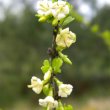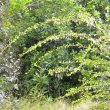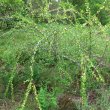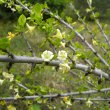| Botanical Name |
|
| Family |
|
| Pronunciation |
|
| Common Name(s) |
English: Small Bone-apple
Afrikaans: Kleinbeenappel
IsiXhosa: intsinde; umgxube
IsiZulu: umDondwane; umGogwane
|
| Plant Group |
- Shrub A woody plant of relatively low height, having several stems arising from the base and lacking a single trunk; a bush.
|
| Plant Size |
- Medium
| Tree | 10m to 16m |
| Shrub | 1m to 2m |
| Perennial/ground cover | 40cm to 60cm |
| Bulb | 40cm to 60cm |
| Succulent | 40cm to 60cm |
|
| Position |
- Canopy Shade Canopy shade is found below closely grown trees where some light filters through. Ideal for the protection of herbaceous plants.
- Light or Dappled Shade Found below trees with sparse, open foliage. Ideal for the protection of herbaceous plants.
- Partial Shade The area is in shade for part of the day and in full sun for part of the day.
- Sun The area is in full sun for all or most of the day, all year round.
|
| General Information |
- Drought Tolerance: High The plant is well adapted to arid conditions; it can survive long periods of drought and high temperatures without extra water.
- Evergreen Plants that have leaves all year round.
- Fragrant / Aromatic These plants posses a strong, usually pleasant odour.
- Frost: Tender A plant that will not survive any frost or low winter temperatures.
- Water Wise Plant species originating from low rainfall regions that require less water to survive and thrive than other plant species.
- Wind Tolerant Plants able to withstand the effect of strong winds.
|
| Specific Information |
The main stem of Coddia rudis is usually short and multi-stemmed with arching branches. It forms a compact shrub when browsed by game. The small, shiny leaves are borne in clusters or on opposite sides of the stems. This shrub is best used in an informal garden, a wild garden or an exclusion zone.
|
| Ad Break |
|
| Flowers |
| Description |
flowers are small (10 – 15 mm diameter), bell-shaped with 5 lobes, turning yellow with age
|
| Season |
- Spring to Summer Plants will seldom bloom for the entire season as given in the list, but should flower during a period within these parameters.
|
| Colour |
|
| Growth Rate |
- Moderate Specifying growth rate can be very misleading as there is considerable variation of growth rate depending on type and species of plant, available water, supplementary feeding, mulching and general care, as well as the plants suitability and adaptability to the garden environment.
|
| Plant Uses |
- Attracts bees, butterflies or other insects This plant attracts insects which can be food for birds or other creatures in your garden.
- Attracts Birds This plant will attract birds.
- Boundary A plant useful for planting around the edges of the property to form a green or colourful backdrop, an impenetrable hedge, to hide walls or create privacy.
- Filler Either a fast growing tree or shrub used temporarily to fill in an area while the permanent plants grow to a desired size, or a plant used to fill gaps in borders or beds.
- Suitable for coastal gardens Plants adapted to dry, sandy soil, forceful wind, limited rainfall and intense sunlight.
- Wild Garden An indigenous garden planted for the benefit of wildlife and birds. Provides food, water, a variety of mini-biomes and no poisonous chemicals are used.
|
| Distribution and Habitat |
in South Africa in the provinces of the Eastern Cape , KwaZulu-Natal and Mpumalanga, and also in Mozambique, Zimbabwe and Swaziland, in dune forest, bushveld, woodlands and along forest margins
|
| Planting Suggestions |
For best results plant in a mixture of garden soil, a handful of bone-meal and compost. Mulch thickly and water well until established.
|
| Medicinal Uses |
The fruit is eaten by people and birds and the leaves are heavily browsed by game.
|
| Ad Break |
|










Comments
Xhosa plant names
This site is very intresting
Xhosa plant names
Hello Ndzumo
Thanks for the compliment. Several plants have ten or more names in some of the languages and I have had to choose only two or three, so the lists are not entirely complete.
Is this species also
Is this species also palatable or acceptable for goats to browse?
Discuss this plant
Share knowledge, ask a question or give an experience.